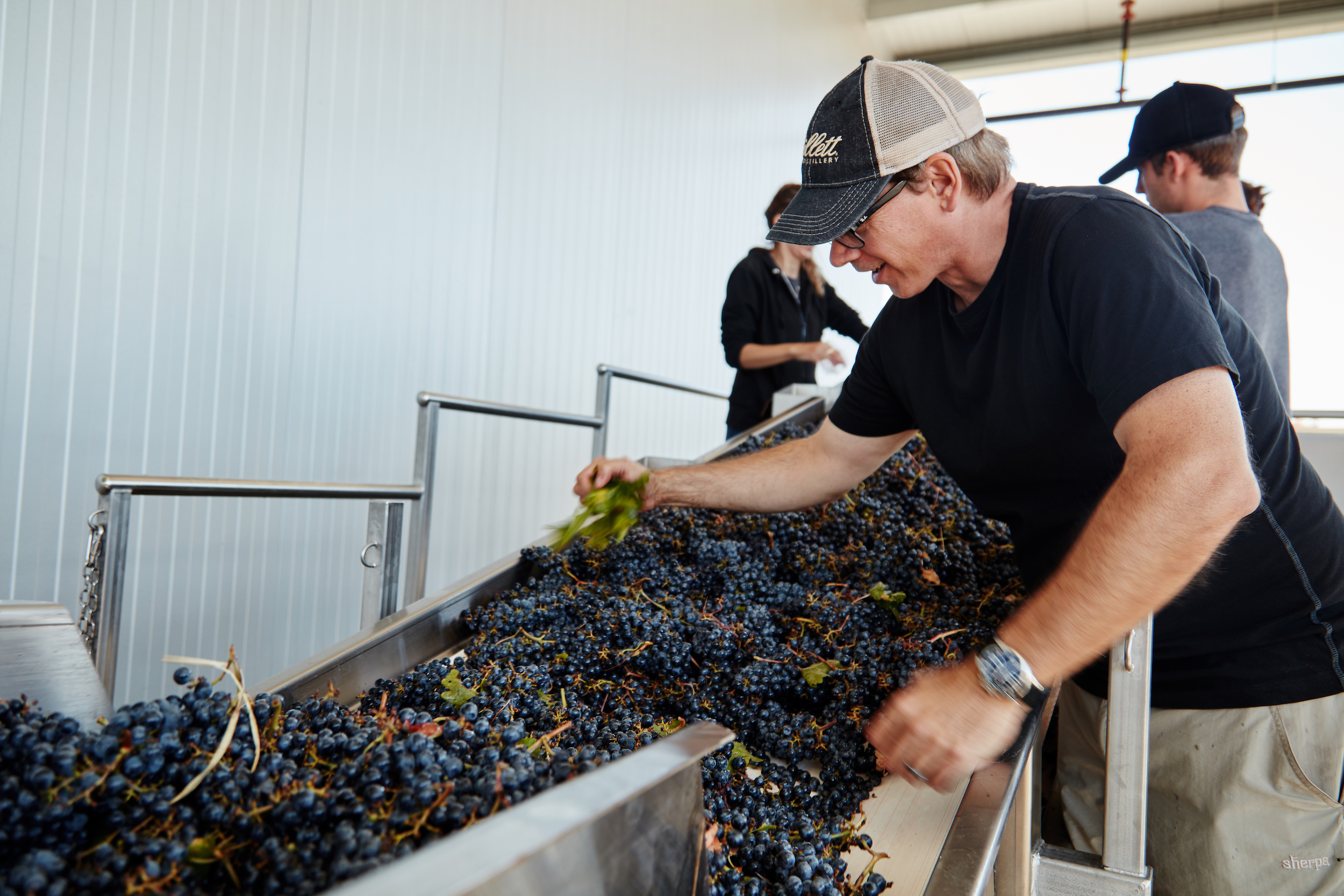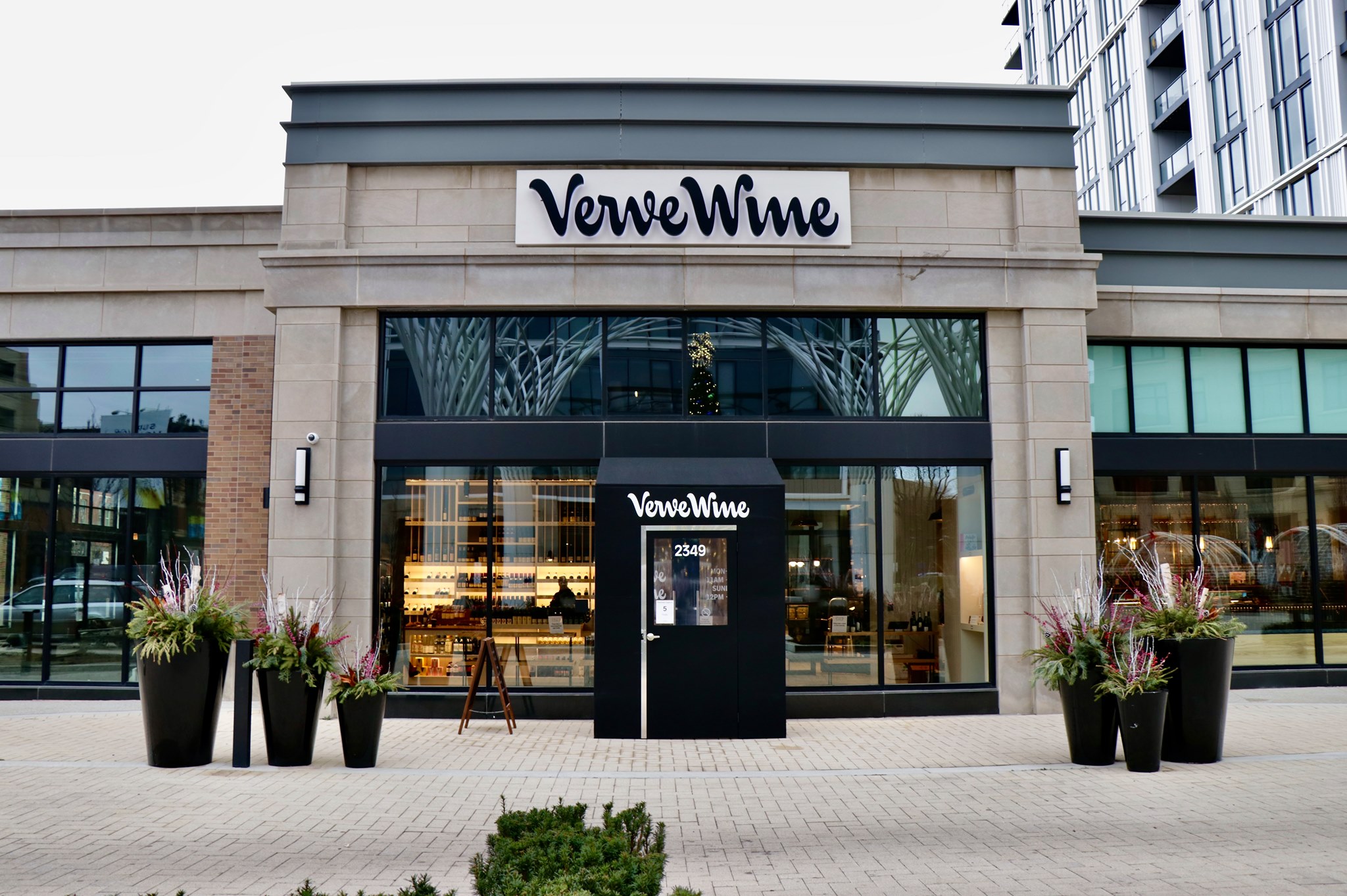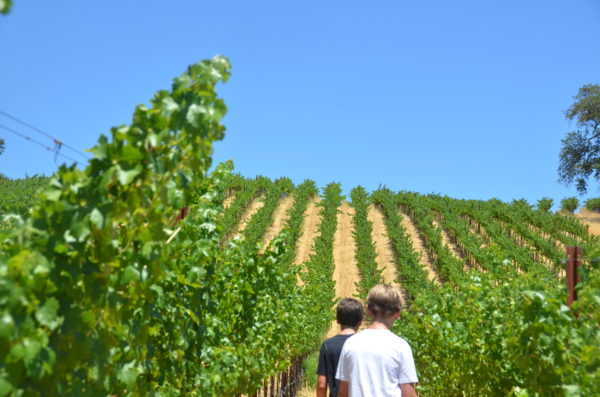
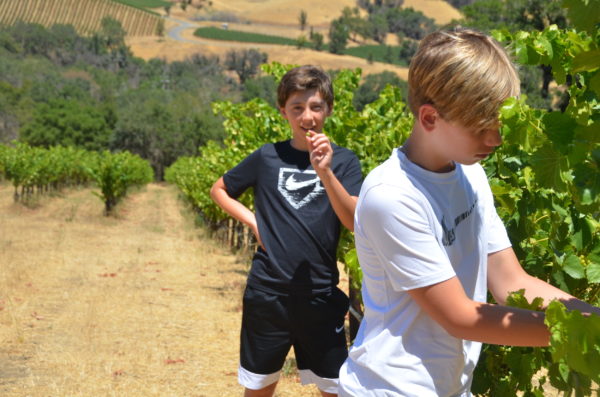
welcome to camp mila
Dear Friends,
Every summer, when most kids head off to camp, we pack up Roco and Luca and take them to Sonoma.
The plan, in our minds, is to teach them how to work in the vineyard. In their minds, there is no plan… other than to run wild.
The moment we arrive at at our wine farm, we lose sight of the boys. They chase the dog, the horse, the cows, and the chickens around until they’re exhausted enough to focus on something.
And then they channel that focus on the Gator—the farm utility vehicle—which they view as their personal entertainment device. Paco’s son, Chico, is happy enough to oblige them with bumpy rides around the property.
Every now and then, we have a boy sighting. As with any feral creature, we approach them slowly and speak softly. We beckon them over, gently talk to them about how the vineyard is doing, and let them taste a grape or two.
They do seem curious, but then, eventually they dart off. We just hope they’ve absorbed something. Because someday, they’ll be tending these vines.
We hope your family enjoys summer as much as we do.

from loretta’s sonoma table
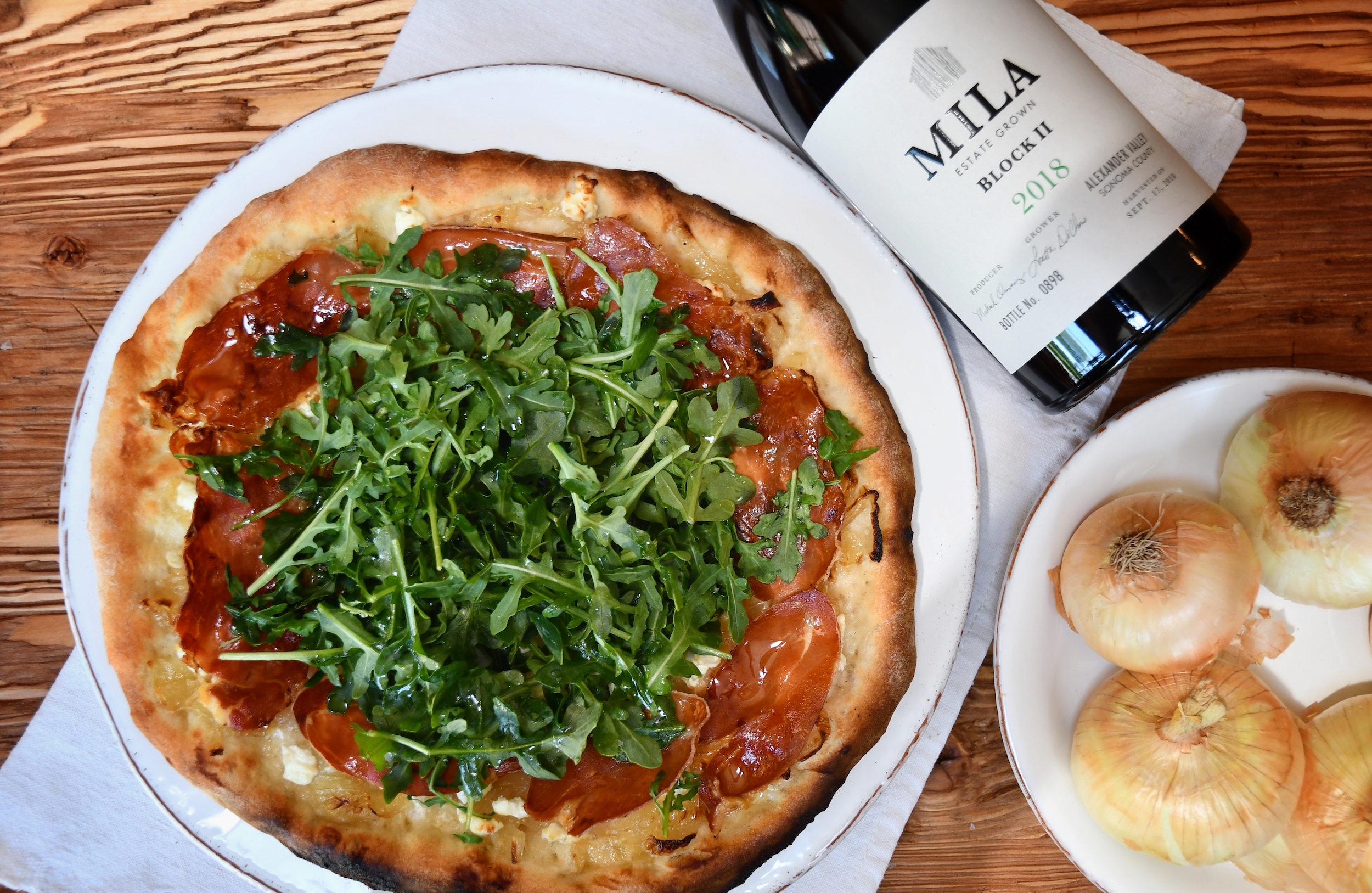
summer pizzas
caramelized onion, prosciutto, goat cheese & arugula
avocado, jalapeño, cilantro, lime & onion
The key to a successful pizza is a reliable, delicious dough. About 15 years ago, I purchased a Mugnaini wood-fired oven and took a fabulous weekend immersion class in open-hearth cooking with Andrea Mugnaini in Healdsburg, Sonoma. I’ve been making this dough ever since, and it has never let me down.
As for the toppings, Andrea Mugnaini’s Caramelized Onion, Prosciutto, Goat Cheese & Arugula Pizza (shown in the photo above) is a household standby for us, as well. You can never go wrong in our family by combining sweet and salty flavors.
I’m shaking things up a bit this year with my Avocado, Jalapeño, Cilantro, Lime & Onion rendition, inspired by a pizza we ordered at Jean-Georges Vongerichten’s Matador Room restaurant in Miami. The menu at the historic Matador Room is a fusion of Caribbean, Spanish, and Latin American cuisines, and includes an extensive pizza list, as well—it turns out that Italian cuisine has made it to all corners of the world!
Note: This recipe serves 4. If you have a pizza oven, you’ll need a pizza board. You can also try this recipe in a standard oven or grill, using a preheated pizza stone. You’ll also need a plastic bag in which to store the dough in the fridge. PRINTER-FRIENDLY VERSION
24-hour pizza dough
Ingredients
1 teaspoon active dry yeast
4 cups “00” flour
1 teaspoon salt
1 ¾ cups water, divided
1 tablespoon olive oil
Directions
Prepare the dough a day in advance so that it can firm in the refrigerator overnight. Begin with ¼ cup hot tap water in a small bowl. Add yeast and let it sit 5 minutes until yeast is hydrated and creamy, then mix until smooth.
Place flour and salt in a mixing bowl. Add yeast mixture and remaining water. Knead the dough 6-8 minutes.
Drizzle the tablespoon of oil in the bottom of a tall kitchen garbage bag, then place the dough in the oiled bottom of the bag. Tie the bag top, leaving room for dough to rise, and place in the refrigerator overnight.
A couple of hours prior to making your pizzas, place the dough in a metal bowl and cover with a cloth to bring to room temperature. Twenty minutes before cooking, cut the dough into four equal sections. Form each section into a small ball and allow to proof in a lightly floured proofing bin (if you have one) or on a floured counter or board with a towel covering it.
When you’re ready to bake your pizzas, preheat your oven. If you’re using a pizza oven, preheat it to 650 degrees. If you’re using a standard oven, preheat it, and your pizza stone, to 500 degrees.
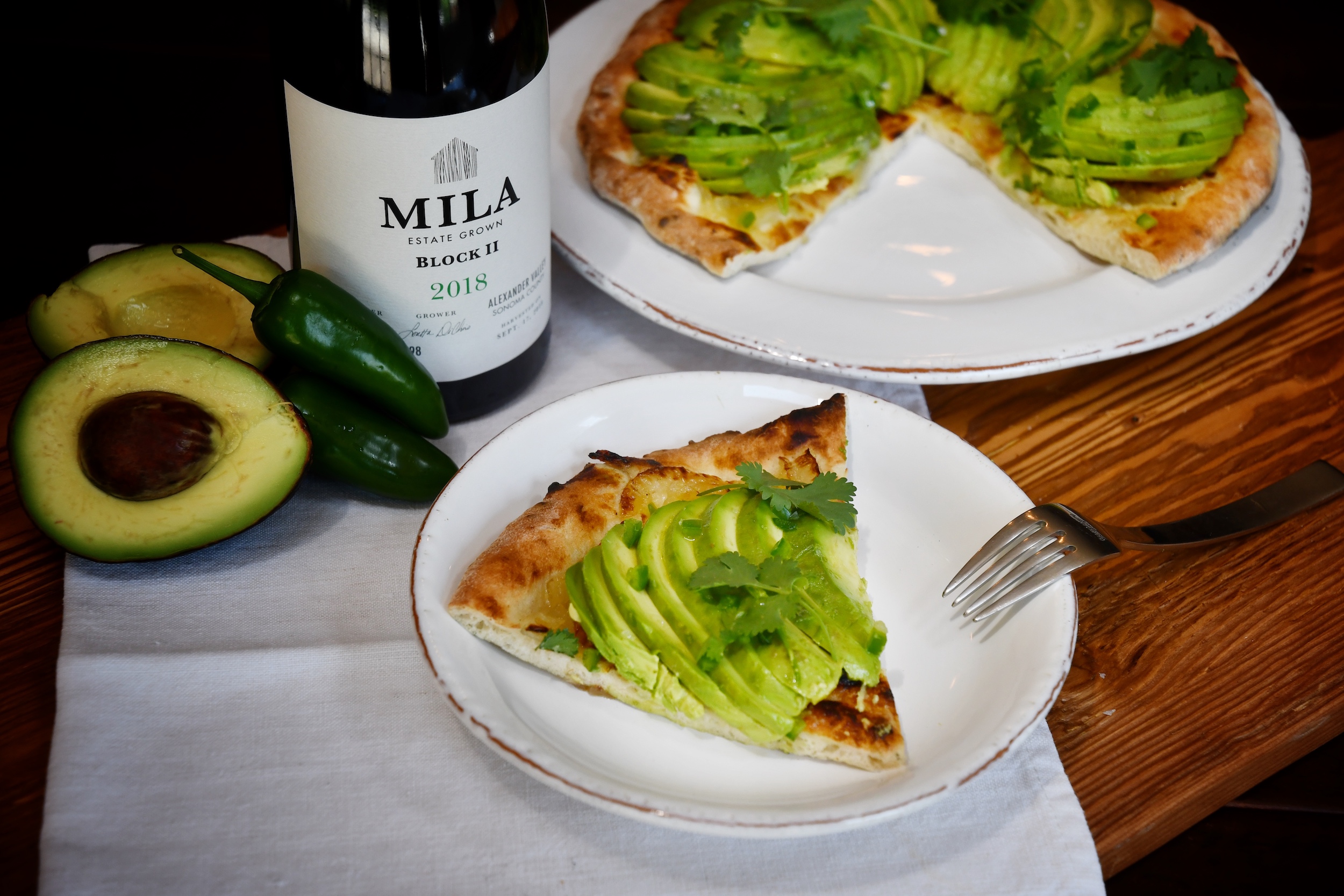
caramelized onion, prosciutto, goat cheese & arugula pizza
Ingredients
1 sweet onion, halved and sliced thin
1 tablespoon sugar
¼ cup olive oil
½ cup goat cheese
1 (6-8 ounce) pizza dough ball
½ cup fresh arugula, loosely packed
6 to 8 slices thin-cut prosciutto
Directions
Place onions, olive oil, and sugar in pan and sauté on medium-high heat for about 10 minutes, until onions caramelize. Stretch a ball of dough to form a circle and place it on your pizza board or cooking stone. Lay the caramelized onions over the dough first. Add prosciutto slices until covered, then distribute goat cheese evenly in dollops.
Slide your pizza off your board into your wood-fired oven and bake at 650 degrees for 2-3 minutes. Alternately, place your pizza stone in your standard oven and bake at 500 degrees for approximately 8-10 minutes. Remove lightly browned pizza from oven, add arugula, slice, and serve.
avocado, jalapeño, cilantro, lime & onion pizza
Ingredients
1 (6-8 ounce) pizza dough ball
2-3 medium avocados, halved and sliced thin
1 jalapeño, seeded and chopped small
juice of 1 lime
¼ cup cilantro leaves, loosely packed
2 tablespoons olive oil
½ small white onion, sliced thin
Directions
Stretch a ball of dough to form a circle and place it on your pizza board or cooking stone. Add olive oil and onions. Slide your pizza into your wood-fired oven at 650 degrees for 2-3 minutes or bake on a stone in a standard oven set to 500 degrees for approximately 8-10 minutes. Once cooked, arrange slices of avocado, jalapeño, and cilantro on top. Sprinkle with a squeeze of lime juice and serve.
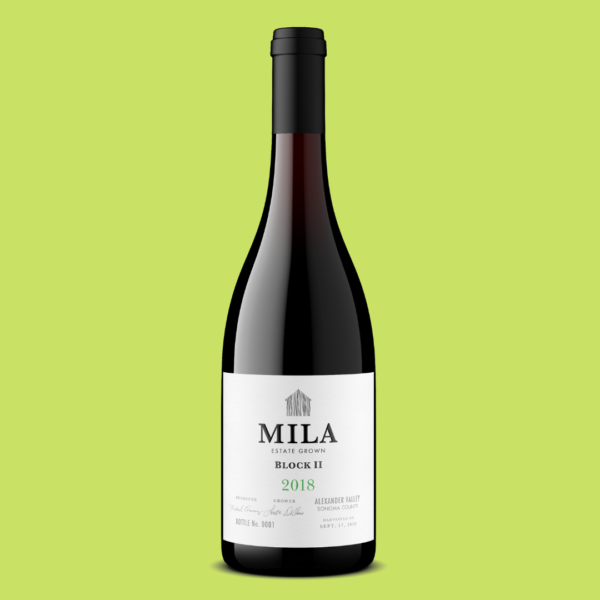
the wine pairing
People tend to sip whites and rosés in the summertime, but I must say that the red fruit flavors and spicy notes of our Block II Grenache just sing with a pizza right out of the oven, all year long.
This wine has the flexibility to complement everything from cilantro to caramelized onion, or whatever other toppings you devise for your next pizza.
notes from the vineyard
defining ripeness
This time of year, there’s no mistaking when the delicious fresh peaches at the farmers’ market are ripe. They have a rosy hue, their skin gives a bit when you press down, and they smell… divine.
Winegrowers don’t have it so easy when it comes to defining ripeness, however. Pop a grape in your mouth on a sunny August afternoon in the vineyard and it’s soft, sweet and flavorful. The next morning, after a chilly night hanging on the vine in the breeze, another grape from the very same bunch has a firmer skin and higher acidity level.
Sugar ripeness in each individual berry—the technical term is brix—comes and goes as the air temperature changes. So winegrowers are more interested in identifying maturation across the entire plant. We call this phenolic ripeness.
Pick too soon and the grape clusters will have green stems and seeds that will impart a mouth-puckering astringency to the juice the moment you crush them. Harvest too late and those stems and seeds will be so dry and brown—fully lignified, as we say in the vineyard—that the wine will lack character and longevity.
Many years ago, our winemaking mentor, Zelma Long, tested some of our all-time favorite wines. The phenol numbers for L’Ermita, the ageworthy wine from Álvaro Palacios that rocks our world, were off the charts. We learned that higher phenolics make for a more structured, long-lasting wine, but also that it’s best to achieve those high numbers naturally—through attentive farming rather than through manipulation in the cellar.

Some wineries go so far as to bring in ripeness consultants, who test grape clusters incessantly in an effort to pinpoint the precise moment to harvest. The end goal, in these cases, is either to make a wine that earns the maximum possible score from the critics, or to make a wine that tastes the same, no matter what the vintage. Our approach is more vintage-driven. We don’t let numbers drive our winemaking, and we want our wines to reflect the distinct conditions of each growing season.
Our biodynamic farming practices naturally encourage balanced vine ripening and higher phenolic levels. So while we do a bit of lab testing just to confirm that our grapes are on track, we mostly rely on our senses to determine when to harvest.
First, we look at the stems. They should be equal parts green and brown, and not shriveled. Then we taste. We know we’ve achieved the ideal ripeness level when the grape flesh is sweet but the skins and seeds are still a bit astringent, as these phenolics will ensure longevity in the eventual wine.
This year, we’re estimating that our grape clusters—and vines—will be fully ripe and ready for harvest by late August. And we’ll be checking the vineyard every day until then, just to be sure.

memberships now available
We have heard from many of you that you want guaranteed access to our wines. We are pleased to extend to you an invitation to join our 6- or 12-bottle wine clubs. Memberships include free tastings at our Sonoma winery for up to six people, priority invitations to upcoming tasting events, and access to our private epicurean social club, Sonoma Table, coming soon to Brecksville, Ohio.
Wines are shipped to your doorstep twice annually. Selections are customizable upon request, and members receive a 20% discount.
Thank you for all of your support for our limited-production, biodynamically farmed, world-class wines!
events
Aug. 1: Afternoon Tasting, Verve Wine, Chicago, IL
Aug. 20: Winemaker Dinner, Firestone Country Club, Akron, OH—PURCHASE TICKETS
Sept. 30: Winemaker Dinner, The Auberge Lodge at Blue Sky, Park City, UT
Oct. 1-2: Park City Wine Festival, Park City, UT
Oct. 22-23: Gran Fondo Hincapie Celebrity Chef Dinner, Hotel Domestique, Travelers Rest, SC
Or: Book a private tasting at our Sonoma winery. Contact Loretta at 216-952-1550 to arrange your appointment.
